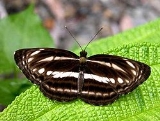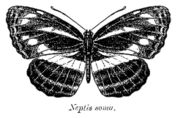
Neptis soma
Encyclopedia
The Sullied Sailer, Neptis soma is a species of nymphalid
butterfly
found in South Asia
.
 Males and females, upperside fuliginous black, with somewhat sullied white markings. Fore wing: discoidal streak narrow, the apex truncate, triangular spot beyond narrow, very elongate; discal spots small, oval, all well separated; postdiscal transverse series of spots complete. Hind wing: subbasal band very narrow, slightly sinuous; discal and subterminal pale lines very obscure ; postdiscal series of spots transverse, very narrow, often indicated only by a pale band.
Males and females, upperside fuliginous black, with somewhat sullied white markings. Fore wing: discoidal streak narrow, the apex truncate, triangular spot beyond narrow, very elongate; discal spots small, oval, all well separated; postdiscal transverse series of spots complete. Hind wing: subbasal band very narrow, slightly sinuous; discal and subterminal pale lines very obscure ; postdiscal series of spots transverse, very narrow, often indicated only by a pale band.
_at_jayanti,_duars,_wb_w_img_5423.jpg) Underside chocolate reddish brown, markings as on the upperside, but broader and slightly diffuse. Fore wing with the discoidal streak and the triangular spot beyond it diffusely connate, some transverse linear white markings on either side of the postdiscal series of spots; the wing below vein 1 pale greyish brown. Hind wing: the discal and sub-terminal pale markings of the upperside represented by more clearly defined, very narrow, white bands, with, in the female, the addition of a terminal white similar band.
Underside chocolate reddish brown, markings as on the upperside, but broader and slightly diffuse. Fore wing with the discoidal streak and the triangular spot beyond it diffusely connate, some transverse linear white markings on either side of the postdiscal series of spots; the wing below vein 1 pale greyish brown. Hind wing: the discal and sub-terminal pale markings of the upperside represented by more clearly defined, very narrow, white bands, with, in the female, the addition of a terminal white similar band.
Antennae black; head, thorax and abdomen fuliginous black ; beneath dusky white.
_at_jayanti,_duars,_wb_w_img_5428.jpg) Males and females, upperside ground-colour a more dusky fuliginous; the markings broader and slightly whiter, not sullied white. Underside :ground-colour a shade brighter.
Males and females, upperside ground-colour a more dusky fuliginous; the markings broader and slightly whiter, not sullied white. Underside :ground-colour a shade brighter.
Race kallaura, Moore. Of this form I have seen only a few specimens. Judging by the types, which are now in the collection of the British Museum, it differs less from the typical form than do any of the other races. As in N. soma, the markings are small and narrow; the subbasal band of the hind wing is, however, attenuated at each end, and not of even width, underside : ground-colour very much paler and somewhat ochraceous, the anterior and posterior sets of spots of the discal series closer together respectively ; the postdiscal band on the hind wing equal in width to the subbasal band.
Recorded only so far from Travancore.
Race hampsoni, Moore. Very closely allied to the typical form, but the markings pure white and broader in both seasonal forms, as in the race clinia. Upperside fore wing: the spots of the discal series oval, outwardly rounded. Underside: ground-colour dark ferruginous, the markings broad as on the upper-side; the spots of the discal series, though closer to each other than in the typical form, still not connate, or forming an upper and lower band as in the race clinia.
Recorded from the Nilgiris; Anaimalai Hills and Mysore.
Race clinia, Moore. Differs in both the dry- and wet-season broods from the typical form as follows:—Upperside fore wing: discoidal streak and spot beyond generally much closer together, only separated by a narrow line; discal spots much larger, outwardly truncate. Hind wing: subbasal band on the whole broader- Underside: ground-colour paler, almost ochraceous in some specimens; differences in the markings from the typical form similar to those on the upperside; discoidal streak on fore wing continuous, only indented above and below ; the lower four spots of the discal series by themselves and the upper three by themselves connate ; subbasal band on hind wing as a rule very broad.
The Andamans.
Nymphalidae
The Nymphalidae is a family of about 5,000 species of butterflies which are distributed throughout most of the world. These are usually medium sized to large butterflies. Most species have a reduced pair of forelegs and many hold their colourful wings flat when resting. They are also called...
butterfly
Butterfly
A butterfly is a mainly day-flying insect of the order Lepidoptera, which includes the butterflies and moths. Like other holometabolous insects, the butterfly's life cycle consists of four parts: egg, larva, pupa and adult. Most species are diurnal. Butterflies have large, often brightly coloured...
found in South Asia
South Asia
South Asia, also known as Southern Asia, is the southern region of the Asian continent, which comprises the sub-Himalayan countries and, for some authorities , also includes the adjoining countries to the west and the east...
.
Wet season form

_at_jayanti,_duars,_wb_w_img_5423.jpg)
Antennae black; head, thorax and abdomen fuliginous black ; beneath dusky white.
Dry season form
_at_jayanti,_duars,_wb_w_img_5428.jpg)
Race kallaura, Moore. Of this form I have seen only a few specimens. Judging by the types, which are now in the collection of the British Museum, it differs less from the typical form than do any of the other races. As in N. soma, the markings are small and narrow; the subbasal band of the hind wing is, however, attenuated at each end, and not of even width, underside : ground-colour very much paler and somewhat ochraceous, the anterior and posterior sets of spots of the discal series closer together respectively ; the postdiscal band on the hind wing equal in width to the subbasal band.
Recorded only so far from Travancore.
Race hampsoni, Moore. Very closely allied to the typical form, but the markings pure white and broader in both seasonal forms, as in the race clinia. Upperside fore wing: the spots of the discal series oval, outwardly rounded. Underside: ground-colour dark ferruginous, the markings broad as on the upper-side; the spots of the discal series, though closer to each other than in the typical form, still not connate, or forming an upper and lower band as in the race clinia.
Recorded from the Nilgiris; Anaimalai Hills and Mysore.
Race clinia, Moore. Differs in both the dry- and wet-season broods from the typical form as follows:—Upperside fore wing: discoidal streak and spot beyond generally much closer together, only separated by a narrow line; discal spots much larger, outwardly truncate. Hind wing: subbasal band on the whole broader- Underside: ground-colour paler, almost ochraceous in some specimens; differences in the markings from the typical form similar to those on the upperside; discoidal streak on fore wing continuous, only indented above and below ; the lower four spots of the discal series by themselves and the upper three by themselves connate ; subbasal band on hind wing as a rule very broad.
The Andamans.
See also
- NymphalidaeNymphalidaeThe Nymphalidae is a family of about 5,000 species of butterflies which are distributed throughout most of the world. These are usually medium sized to large butterflies. Most species have a reduced pair of forelegs and many hold their colourful wings flat when resting. They are also called...
- List of butterflies of India
- List of Butterflies of India (Nymphalidae)

